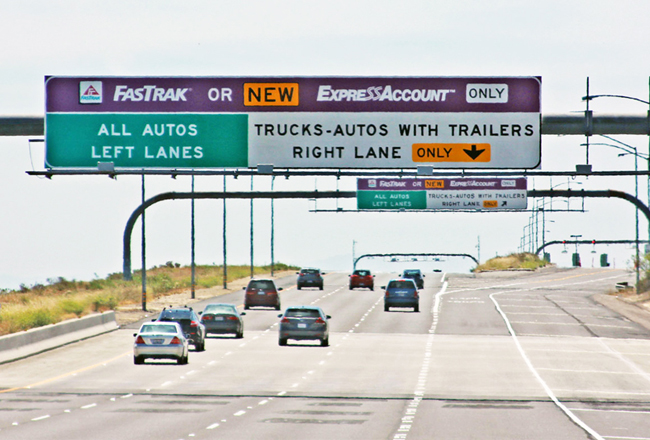The fight over highway tolls between Connecticut Gov. Ned Lamont and state Senate Republicans has heated up again, centered in part on an internal Department of Transportation memo.
The memo ”“ whose creation predates Lamont”™s taking office ”“ details a plan for bonding  limits at $750 million for fiscal year 2019 and $800 million per year until fiscal 2023, when toll revenues would presumably begin. The DOT said that plan “would have significant impacts on our capital program, severely constricting the number of new projects that advance in the current, and future years.”
limits at $750 million for fiscal year 2019 and $800 million per year until fiscal 2023, when toll revenues would presumably begin. The DOT said that plan “would have significant impacts on our capital program, severely constricting the number of new projects that advance in the current, and future years.”
Republican opponents hold that Lamont”™s plan would also divert $250 million in new car taxes away from the state”™s Special Transportation Fund.
Senate Republican Leader Len Fasano, long an opponent of tolls, called the memo “shocking and alarming,” maintaining that it “confirms our concerns that the governor”™s proposals will have a devastating effect on transportation infrastructure ”¦. The DOT says these policies would starve transportation funding, allow our roads and bridges to further deteriorate, and put more financial burdens on the backs of residents.”
Tolls would not be operational until at least 2024, Fasano said, with real revenue not coming in until 2026. “During that time,” he continued, “the governor”™s transportation strategy would dramatically cut infrastructure investments, eliminate most if not all state funded transportation programs and would cut local transportation aid for towns and cities.
“The DOT also confirms that tolls will not only be expensive to implement, but will be used to bond more,” Fasano said. “While Republicans have called for reprioritizing what the state is already borrowing, limited by the new bond caps which Republicans insisted on including in the bipartisan budget, tolls would result in borrowing above and beyond that level.
“The DOT also makes it clear that the administration”™s strategy violates the public trust, with the DOT calling it ”˜inconsistent”™ with the transportation lockbox,” he said. “This memo does not even include an analysis of the how the governor”™s budget would bankrupt the Special Transportation Fund by removing car sales tax revenue set to go into the fund over the next few years. If DOT attributes all this damage to eliminating just $250 million for transportation today, I can only imagine the damage that will be caused by stealing an additional $1.2 billion in transportation funding over the next five years as the governor”™s budget proposes.”
The GOP”™s alternative “Prioritize Progress” plan calls for $684.6 million to $863 million of annual bonding over the next nine years for transportation projects, along with the continuation of Special Tax Obligation bonds for the regular DOT capital program, and a hard cap of $2 billion on annual general obligation bonds.
“If improving roads and bridges is truly our state”™s priority, we should all be concerned about the governor”™s policy proposals and what the DOT memo says,” Fasano said. “The Republican ”˜Prioritize Progress”™ plan is a proven, effective way to fund transportation. It is the only plan that will allow us to start new transportation projects today and to properly fund transportation without asking for any more from Connecticut taxpayers and abiding by the new borrowing caps we have been fighting for.”
Lamont’s Chief of Staff Ryan Drajewicz, calling the GOP plan “Prioritzed Borrowing,” countered that the state cannot issue bonds with an insolvent Special Transportation Fund, which he said would occur by 2027.
“Aren”™t the Republicans always preaching fiscal restraint?” he asked. “It”™s unreal to hear them advocating for increased borrowing, paid for 100 percent by Connecticut residents, including the principal plus interest. Their ”˜Prioritized Borrowing”™ plan suggests taxpayers pay for issuing $750 million of debt ”“ each year and above and beyond current levels ”“ to shore up the Special Transportation Fund.
“They know, we know and Connecticut residents know that borrowed money isn”™t free,” Drajewicz said. “To pay for this level of borrowing, Connecticut residents can expect an income tax increase, in addition to what will likely be a negative outlook by the ratings agencies that typically frown at this level and type of borrowing.
“We have yet to see another plan that reduces the cost to Connecticut taxpayers by enabling out-of-state drivers to foot 40 percent of the bill,” as does the tolls plan, he added. “The governor”™s plan both stabilizes the Special Transportation Fund and provides the recurring, sustainable revenues needed to bring our transportation system to the 21st century and get our economy growing again.”
Lamont has said that tolls could raises as much as $1 billion in annual revenue.
Although three bills involving highway tolls have passed the state Senate, their chances of passage in the House remain uncertain, with a number of Democrats saying they might side with Republicans, who are nearly unanimously opposed to tolling.


















